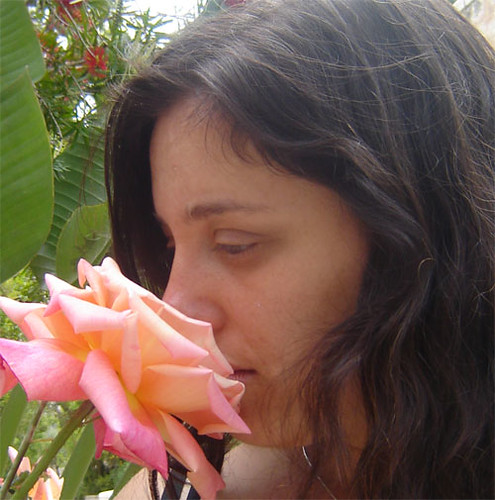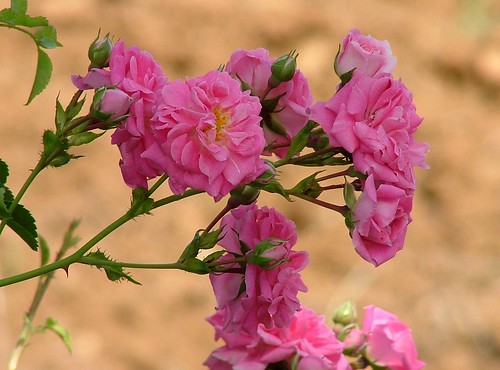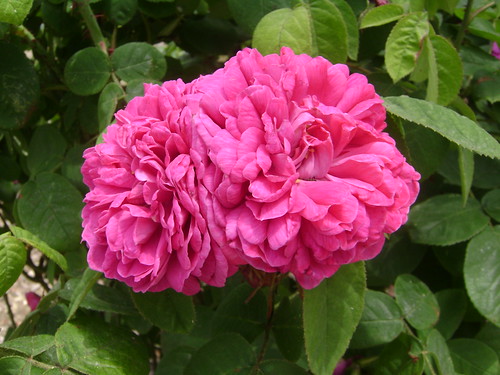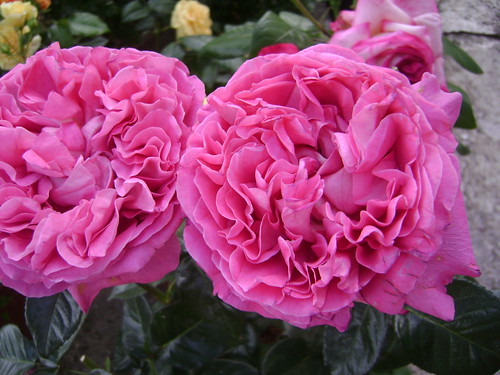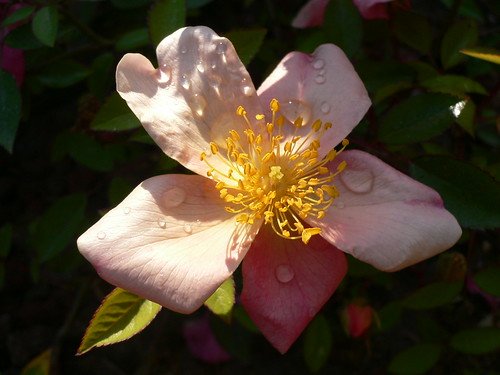The nightingale, and none beside, knows the full worth of the rose for many a one reads the leaf and understands not the meaning thereof
– HafizThere is so much to be said about roses. And there is no better time to say it than now: winter is coming to its end, and celebrations of life and love in the form of fertility festivals and chaotic carnivals where everything is possible have now been replaced by Hallmark holidays of subdued emotions, appropriately framed with heart-shaped molds and rose-red hues. Finding ways to express emotions have never been more trying. And saying it with roses, as cliche as this may seem, might be the only way to remain genuine and leave something to the imagination.
BotanyRose is a perennial flowering shrub from the
Rosacea family. The leaves are serrated and most of the rose bushes have thorns on their branches. There are over 100 species of rose. With the exception of some Southeast Asian rose species, roses are deciduous, and lose their leaves in the winter. The fruit of the roses is a berry called rosehip. Roses with many closed petals may not produce fruit at all, as the insects cannot access the pollen. Roses vary in sizes of the plant as well as the flower. There are some climbing varieties, some plain bushes. Rosehips are especially rich in vitamin c (especially those from the dog rose – Rosa canina – native to Lebanon and Israel; and Rosa rugosa, aka Japanese rose).
Cultivars, Hybrids etc.Cultivated roses are hybrids of various types have more petals (which are, in fact, mutated stamen). The most important modern roses are the hybrid tea roses, which come hybrid of the above species with China roses. The China roses (Rosa chinensis) were less hardy, but produced successive blooms from summer through fall; and also contributed to the shape of modern roses (including the classic “bouquet” roses that we see at the florists); as well as more colour possibilities in hues of coral, orange and yellow.
20th century rose breeders focused so much on the size and colour of the roses, that most of the newer breeds of roses are not nearly as fragrant as the antique garden roses. And roses that are found at the florists usually have no scent at all.
Origins & History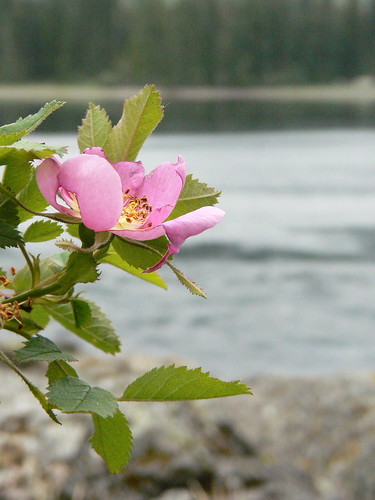 Tidal Rose, originally uploaded by Ayala Moriel.
Tidal Rose, originally uploaded by Ayala Moriel.
Most rose species are native to Asia, with only a few native to Europe, America and Northwest Africa. The following species are the ones used mostly in Western perfumery:
Rosa centifolia, originating in Persia, where it is called “Gul”. From there it spread to India (its Hindi name is Gulab-ka-phool)
; Rosa damascena, originally from Damascus (Syria);
Rosa gallica, the French or the apothecary rose, native to central and southern Europe;
Rosa alba – a hardier type, white in colour.
China rose (Rosa chinensis) from the mutabilis variety is most important in breeding the Hybrid Tea roses of both old garden roses and modern ones. They are called that way because they change colours throughout their bloom: vermillion orange buds open to coppery pink flower and later on a deep crimson.
The biochemical makeup of the Western roses is quite different than that of the China roses (
Rosa chinensis), as is their colour. Western roses are white, red or pink; while the China roses are yellow or orange. The biochemical implications, simply put, are that Western roses are dominated by geraniol, citronellol and damascones; while the China roses posses various carotenoid biochemicals, such as beta ionone. The result is an aroma that is quite different – sweeter, fruitier and reminiscent of violets and tea.
Myth and NomenclatureThe name for rose comes from the Latin “Rosa” (red), which originates in the Greek “rhodion” and ancient Farsi “wurdi” (flower). The name “rose” also means pink or red in a number of Romance languages, as well as in Greek and in Polish.
According to Greek mythology, rose origins were in the body of a young nymph found by Flora. Venus (Aphrodite) has transformed it into the rose plant, which was than blessed by Apolo’s sunrays, given a sweet nectar by Bacchus (the wine god) and with fruit by Pomona, and blessed with the most beautiful flowers by Flora and the Celestials (Poucher’s Perfumes, Cosmetics and Soaps, Vol. 2, 1959, p. 205). Rose was originally white, but after the thorns have wounded Aphrodite’s feet, her blood has turned roses red.
War of the Roses
The War of the Roses is a chapter in English history (around the time between 1455-1485), where civil wars between two dynasties (Lancaster and York) competing for the throne, and their supporters took place. Each of the dynasties had a rose symbol -
Red Lancashire rose/ Red Rose of Lancaster
and the
White Rose of York. When the Tudors took the throne, the War of the Roses ended, and a new symbol was created, called the
Tudor Rose, combining the red and the white, to symbolize union between the two.
Some say there is a reference to that in Lewis Carroll’s Alice in Wonderland, where the cards are painting the white rosebush red, although this is a very
shallow interpretation of Lewis Carrol's work.
Religious and Spiritual Rose SymbolismIn the state of union the single beings of other world are one,
All the petals of the rose are together one.- Muhammad IqbalThe beauty of rose and her perfume and the complexity of her petals made it a subject of
symbolism since ancient times. The only other flower that is known for having an equal breadth and depth of spiritual symbolism is the lotus flower.

Wild roses, like most of the Rosales order (which also includes cherry and almond) have 5 petals, symbolic of the pentagram, or mankind (the 5-pointed star is attributed to the head and the 4 limbs). Symbols of 5-petaled rose are recurring in European art and symbolism (i.e.: the
Rosicrucian order’s
symbol), who only later on in history were exposed to the cultivated, multi-petal rose. And nowadays, rose is the national flower of many countries, not to mention political parties. White rose was the symbol of a peace movement in Germany during World War II.
The multi-petals of cultivated roses grow give the flower the quality of mystery: it hides the stamens and holds its secrets… These petals also grow clockwise, in a spiral movement. This shape alludes to growth, expansion and is a metaphor to the universe. Spiral movement is eternal to both direction – the microcosm and the macrocosm.
Rose was sacred to the Egyptian goddess Isis.
In Hinduism, rose is considered Lord Krishna’s favourite. Hindus wash their alters with rosewater. According to the chakra system, the heart chakra is green, but when we are in love it turns to a rose colour. Likewise, rose flower grows out of a green thorny plant and represents the most elated state of the species (according to
Ivan M. Granger).
In Judaism, rose was mentioned in the Song of Solomon as a thing of beauty found amongst the thorns, and is one of the seven perfumes mentioned in the book. It’s important to note, that there is also a fair amount of confusion between the names “shoshana” (the name for lily in modern days), or “vered” (the modern Hebrew word for rose).

In Kabala, the 22 letters of the Hebrew alphabet are said to form The mystical rose of creation, with the three mother letters forming a triangle in the middle (relating to the three elements – fire, water and air), surrounded by the 7 double letters which are symbolic of the 7 ancient planets, and finally by the 12 single letters, corresponding to the 12 Zodiac signs and the 12 tribes of Israel.
The beauty of rose in Ancient Greece and Rome were attributed to the goddess of love, Venus or Aphrodite. Wild rose was placed on the door of rooms where secret meetings were held. Alchemists considered rose to be associated with the element of earth, with the solar plexus or the heart, and with either the Sun or the planet of Venus.

In Christianity, red roses symbolize the blood of Christ, sacrifice and are associated with the heart. The colour of roses and their sweet, fruity, wine-like scent made them connected to wine, the refined symbol of Christ’s blood.
White roses symbolize the purity and virtue of the Virgin Mary.
Prayer necklaces called Rosaries were made from fragrant rose beads (see recipe
here).
The Muslims loved rose above all other flowers. Mohammed’s sweat said to have the scent of attar of rose, and he is known for his love for women, children and perfumes above all things on this earth.
The Sufis practiced meditation in rose gardens, which are the most important theme in Persian art – Persian miniatures as well as carpet designs depict such rose gardens. A recurring theme in Sufi poetry is that of the rose and the nightingale. The nightingale is the lover, longing for the love of the rose, which he expresses in sad love songs through the night. These are of course metaphors to the Sufi in search for closeness to God.
Different Colours, Different Meanings
In the Victorian Language of Flowers, roses of different colours signify different emotions, meanings and messages for their recipient. Some of these meanings remain valid till modern day.
 White roses: Purity, innocence, e
White roses: Purity, innocence, eternal Love, silence, wistfulness, virtue, purity, secrecy, reverence and humility. The white rose in the hand of The Fool tarot card signify that pure innocence and a "tabula rasa" awaiting learning. White roses are often used in bridal bouquets.
Pink roses: New love, happiness, romance, admiration, sweetness. Dark pink roses express gratitude; while pale pink mean joy of life, youth, energy and passion. Light pink roses are of the most popular after red ones.
 Red roses: True love, passion, desire. These roses are most used among lovers.
Red roses: True love, passion, desire. These roses are most used among lovers.
Red roses also appear in The Empress card in the tarot's major arcana.
 Yellow roses: Friendship, platonic love, jealousy, infidelity, dying love.
Yellow roses: Friendship, platonic love, jealousy, infidelity, dying love.
Orange roses were introduced to Europe only later on, and signify a combination of the emotions that both red and yellow coloured roses represent.
Coral hued roses were especially rare, and meant desire, passion and enthusiasm. Orange roses also mean desire and enthusiasm, but also could mean pride.
Lavender roses: Love at first sight.
Blue roses: Mystery, attaining the impossible
Black roses (which are really just a very dark red): death, farewell, separation, hatred - or rebirth and rejuvenation (which are really the other side of the coin of endings and death).
Medicinal and Therapeutic ApplicationsThe most therapeutic type of rose is the Rosa centifolia (rose of hundred petals). Interestingly, it’s Sanskrit name, shatapattri, has the same meaning. Rose is used in aromatherapy for its soothing properties. It is a heart tonic and also helps to ease women in labour and helps to balance the hormones.
Ibn Sina (Avicenna) employed attar of rose and rosewater for treating ailments of the digestive tract.
The scent of rose gives one a sense of well being. It is an oil that has the greatest effect on the emotions, helping to cope with loss, grief and promote self-esteem and confidence (especially in women). The latter quality makes it act as an aphrodisiac: when a woman feels confident in her sexuality, she feels more at ease to seduce and engage in romantic relationships.
Gulab Lassi is an Ayurvedic rose aphrodisiac.
In Ayurveda, rose is used to balance the heart. It “balances Sadhaka Pitta, the subdosha of Pitta that governs the emotions and their effect on the heart” (reference
here). Rose soothes the heart and the emotions. It also balances the mind, connecting the Sadhaka Pitta to the Prana Vata (the subdosha of Vata dosha that governs the brain, head, chest, respiration, sensory perception, and the mind). Rose is unique in that it balances all three doshas.
Ayurvedic doctors use rose to treat hormonal imbalances that result in amenorrhea; as well as treat migraines and headaches, loss of vision, sore throat, inflamed tonsils; and emotionally – to cope with nervousness, grief. Rosewater can be sprayed onto eyes suffering from inflammation or infection.
Gulkand (a rose petal jam) or Gulkand sharbat (rose syrup) can be eaten on its own, or added to milk or yoghurt, to achieve a cooling effect on the body.
(
sources:
Kamlesh Ayurvedea, and
Medicinal Use of Flowers at Home).
Rosehips are used to treat colds and influenza (because of their high vitamin C content). Rosehips have anti-inflammatory properties, and were used to treats osteoarthritis. They also aid in treating urinary tract problems, and assist in preventing cancer and cardiovascular disorders, because of their high level of phytochemicals such as carotenoid pigments, plant sterols, tocotrienols... (
source).
Flavour & Culinary UsesRoses as a flavour are especially popular in India and the Middle East as an addition to desserts and beverages; and to a lesser extent in Europe, particularly France.
In the Middle East, Persia and India - rosewater is added to sherbets, ice creams and pastries (i.e.:
harissa,
basboosa, baklawa and rasgulla) as well as to flavour fruit salads. Rosewater confections are also popular in Turkey, Greece and the Balkan (Turkish Delight, for example). In the Ukraine, rose petal jam is paired with
vanilla ice cream. Rose petal jam was adopted as an aromatic additive to pastries, pancakes and waffles and pastries such as scones or croissants, and fresh rose petals can be added to
crepes.
Rose petals are also used to flavour tea: Chinese Rose Congou tea is made by perfuming black China tea with layers of fresh rose petals. Some of the petals remain in the tea.
Royal tea is an Assam black tea blend with dried rose petals and vanilla, often served with milk. I particularly enjoy adding rose petal to a milky Earl Gray tea with vanilla. It turns it into a heavenly affair, a soothing and luxurious elixir.
The rosehips are made into a jam or jelly, as they are rich a relatively high in pectin. They are also very popular as a tisane, on their own or as a base for fruit-flavoured tisanes, particularly berry-flavours, because of their sour flavour.
CosmeticsRose otto and rosewater have rejuvenating, moisturizing and anti-aging properties and is an excellent additive to skin-care products and skin-care regime for dry or mature skin. Rosewater tones the skin and gives it a healthy glow, and also is used for cooling the skin in Ayurvedic cosmetics – on the principle that it helps to balance the Bhrajaka Pitta (the subdosha of Pitta that governs the biochemical aspects of the skin).
In Ancient Greece, dried rose petals were ground into a powder and applied to the skin as deodorant (Poucher’s “Perfumes, Cosmetics and Soaps, 1959, vol. 2, p. 206).
Rosewater blended with glycerin is an easy, simple and pure homemade lotion, and can be prepared at home (which will result in a purer product - without the red colouring and any other possible additives or artificial scents used in rosewater & glycerin that is bough off the pharmacy shelves).
Rosehip seed oil is also a wonderful oil to be used in skin care, massage oil and cosmetics. Its high content of oleic, linoleic and linolenic acids, carotenoids and beta-carotene, it has antioxidant and healing properties to the skin, making valuable for cosmetics to prevent dryness and aging, age-spots, wrinkles, as well as for use for various skin conditions such as acne, dermatitis, eczema, psoriasis and more (
reference).
Rose oil added to
facial elixirs will leave your complexion with a youthful glow.
Tomorrow:
Stop to Smell the Roses - Rose in Perfumery



